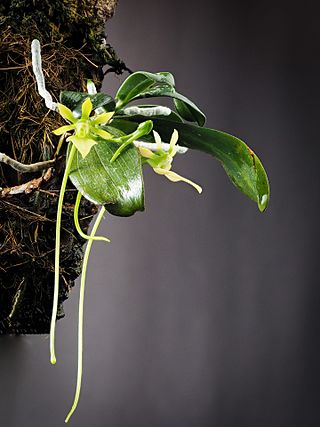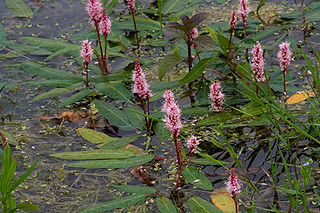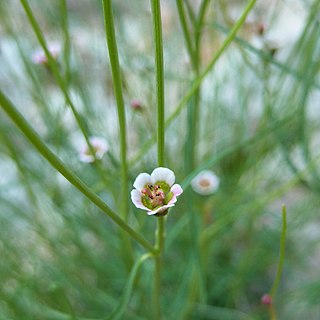
Vascular plants with monopodial growth habits grow upward from a single point. They add leaves to the apex each year and the stem grows longer accordingly. The word Monopodial is derived from Greek "mono-", one and "podial", "foot", in reference to the fact that monopodial plants have a single trunk or stem.

Vanda, abbreviated in the horticultural trade as V., is a genus in the orchid family, Orchidaceae. There are about 87 species, and the genus is commonly cultivated for the marketplace. This genus and its allies are considered to be among the most specifically adapted of all orchids within the Orchidaceae. The genus is highly prized in horticulture for its showy, fragrant, long-lasting, and intensely colorful flowers. Vanda species are widespread across East Asia, Southeast Asia, and New Guinea, with a few species extending into Queensland and some of the islands of the western Pacific.

Phragmipedium is a genus of the Orchid family (Orchidaceae) and the only genus comprised in the tribe Phragmipedieae and subtribe Phragmipediinae. The name of the genus is derived from the Greek phragma, which means "division", and pedium, which means "slipper". It is abbreviated 'Phrag' in trade journals.

Neobathiea, abbreviated as Nbth in the horticultural trade, is a genus of orchids, native to tropical moist broadleaf forests of Madagascar and the Comoro Islands. The genus is named for the French botanist Henri Perrier de la Bâthie.

Saxifraga cespitosa, the tufted alpine saxifrage or tufted saxifrage, is a flower common to many arctic heights. It appears further south in mountainous areas of the Alps, Norway, Scotland, Wales, Iceland, Siberia, western North America and Greenland.

Lathyrus japonicus, the sea pea, beach pea, circumpolar pea or sea vetchling, is a species of flowering plant in the legume family Fabaceae, native to temperate coastal areas of the Northern Hemisphere and Argentina.

Nepenthes benstonei is a tropical pitcher plant endemic to Peninsular Malaysia, where it grows at elevations of 150–1350 m above sea level. The specific epithet benstonei honours botanist Benjamin Clemens Stone, who was one of the first to collect the species.

Verbascum blattaria, the moth mullein, is a flowering biennial plant belonging to the figwort family Scrophulariaceae. A native of Eurasia and North Africa, it has naturalized in the United States and most of Canada since its introduction and has become an invasive species there. It has been declared a noxious weed by the state of Colorado.

Angraecum sesquipedale, also known as Darwin's orchid, Christmas orchid, Star of Bethlehem orchid, and king of the angraecums, is an epiphytic orchid in the genus Angraecum endemic to Madagascar. The orchid was first discovered by the French botanist Louis-Marie Aubert du Petit-Thouars in 1798, but was not described until 1822. It is noteworthy for its long spur and its association with the naturalist Charles Darwin, who surmised that the flower was pollinated by a then undiscovered moth with a proboscis whose length was unprecedented at the time. His prediction had gone unverified until 21 years after his death, when the moth was discovered and his conjecture vindicated. The story of its postulated pollinator has come to be seen as one of the celebrated predictions of the theory of evolution.

Ipomoea nil is a species of Ipomoea morning glory known by several common names, including picotee morning glory, ivy morning glory, and Japanese morning glory. It is native to the tropical Americas, and has been introduced widely across the world.

Potentilla recta, the sulphur cinquefoil or rough-fruited cinquefoil, is a species of cinquefoil. It is native to Eurasia but it is present in North America as an introduced species, ranging through almost the entire continent except the northernmost part of Canada and Alaska.

Phalaenopsis gigantea is a species of orchid endemic to the island of Borneo and was first described in 1909. The specific epithet gigantea refers to the giant size of its leaves, which can grown over 60 cm in length on a mature plant. It is the largest known Phalaenopsis species.

Vanda coerulescens, also known as sky-blue vanda, is a species of monopodial orchid native to Assam and Arunachal Pradesh, India, eastern Himalayas, southern Yunnan province in China, Myanmar and Thailand.

Paeonia ludlowii, is a medium high, deciduous shrub, belonging to the peonies, that is endemic to southeast Tibet. In Tibet it is known as lumaidao meaning "God’s flower". The vernacular name in Chinese is 大花黄牡丹 meaning "big yellow-flowered peony". In English it is sometimes called Tibetan tree peony or Ludlow's tree peony. It has pure yellow, slightly nodding, bowl-shaped flowers, and large, twice compounded, light green leaves.

Plectorrhiza, commonly known as tangle orchids, is a genus of three species of flowering plants from the orchid family, Orchidaceae and is endemic to Australia. Orchids in the genus Plectorrhiza are epiphytic or lithophytic herbs with short stems, long, tangled roots, short leathery leaves and small flowers on a short, thin flowering stem. Two species occur in eastern Australia and one is endemic to Lord Howe Island.

Persicaria amphibia is a species of flowering plant in the knotweed family known by several common names, including longroot smartweed, water knotweed, water smartweed, and amphibious bistort. It is native to much of North America, Asia, Europe, and parts of Africa, and it grows elsewhere as an introduced species and sometimes a noxious weed.
Iris vorobievii is a plant species in the genus Iris, it is also in the subgenus of Iris and in the Psammiris section. It is a rhizomatous perennial, from Russia close to the Chinese border. It has long and thin green leaves, similar sized stem and pale yellow or bright yellow flowers with a pale yellow beard. It is cultivated as an ornamental plant in temperate regions.

Euphorbia aaron-rossii, also known as the Marble Canyon spurge, is a perennial, herbaceous plant species of Euphorbia native to Arizona. It's most closely related to E. strictior and E. wrightii, but needs more study.

Symphyotrichum molle is a species of flowering plant in the aster family (Asteraceae) endemic to the Bighorn Mountains of Montana and Wyoming in the United States. Commonly known as soft aster, it is a perennial, herbaceous plant that ranges from 30 to 60 centimeters in height.

Babiana brachystachys is a species of geophyte of 20–30 cm (7.9–11.8 in) high that is assigned to the family Iridaceae. It has cream or pale pink, only slightly mirror-symmetrical flowers that are pink on the reverse with a long narrow tube that splits into six tepal lobes, three stamens, a style that divides in three branches opposite the tip of the anthers and line-shaped leaves that are circular in cross section. It is an endemic species of South Africa that can be found on sandy hills and inland dunes in the Northern Cape province. It flowers in September and October.



















